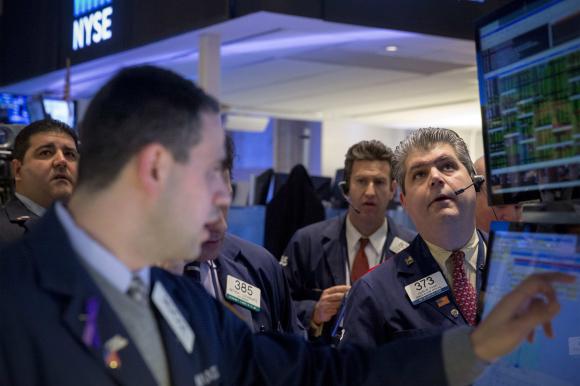
U.S. stocks fell for a fourth day on Wednesday as a World Bank forecast fueled concerns about global economic weakness and copper prices sank, although a late-day rebound in energy shares left the market well off its lows after a volatile session.
The S&P energy index .SPNY ended up 0.1 percent after falling as much as 2.6 percent. It rebounded late in the day as oil prices CLc1 LCOc1 jumped by the most in more than two years ahead of options expiration. Crude oil prices remained near six-year lows despite the day’s jump, however.
S&P 500 materials .SPLRCMA and financial .SPSY sectors were the day’s worst performers, both falling more than 1 percent.
The price of copper CMCU3, a key industrial metal, touched its lowest in five and a half years, weighing on shares of producers including Freeport McMoRan Inc, after the World Bank cut its economic growth forecasts for this year and next.
Adding to investor concerns, U.S. retail sales registered their biggest drop in 11 months in December.
The S&P retail index .SPXRT fell 0.8 percent.
“You look at the obliteration in oil, copper … there are a lot of questions about worldwide demand and growth,” said Michael James, managing director of equity trading at Wedbush Securities in Los Angeles.
“With an earnings season just getting started, there’s a lot of nervousness, given we’ve had six years of up markets. Are we due for a down market?”
The Dow Jones industrial average .DJI fell 186.59 points, or 1.06 percent, to 17,427.09, the S&P 500 .SPX lost 11.76 points, or 0.58 percent, to 2,011.27 and the Nasdaq Composite .IXIC dropped 22.18 points, or 0.48 percent, to 4,639.32.
U.S. crude oil CLc1 settled up 5.6 percent and Brent LCOc1 ended up 4.5 percent, snapping a four-day slide.
The S&P 500 briefly broke below its 120-day moving average, a technical support level, and hit a new low for the year at 1,988.44. S&P e-minis ESc1 also broke support and hit an intraday low for the year.
The S&P 500 is now 3.8 percent below the record high reached on Dec. 29.
Shares of copper producer Freeport McMoRan (FCX.N) tumbled for a second day. Shares ended down 10.9 percent at $18.74 and the stock was the S&P 500’s biggest percentage decliner.
Expectations for U.S. fourth-quarter earnings have fallen sharply in recent months, with growth now estimated at just 3.6 percent compared with an Oct. 1 estimate for 11.2 percent, according to Thomson Reuters data.
JPMorgan Chase & Co (JPM.N), the biggest U.S. bank by assets, ended down 3.5 percent at $56.81 after reporting a 6.6 percent drop in quarterly profit. Wells Fargo & Co (WFC.N) shed 1.2 percent to $51.25 after posting quarterly results.
A large trade in the options on the S&P 500’s tracking ETF (SPY.P) suggested positioning for a further decline in the market within the next week and a half. A trader paid $1.23 a contract for 43,830 SPY puts at the $195 strike price, which corresponds to the 1,950 level on the S&P 500.
Declining issues outnumbered advancing ones on the NYSE by 1,856 to 1,238, for a 1.50-to-1 ratio on the downside; on the Nasdaq, 1,743 issues fell and 994 advanced for a 1.75-to-1 ratio favoring decliners.
The benchmark S&P 500 index posted 13 new 52-week highs and 29 new lows; the Nasdaq Composite recorded 39 new highs and 130 new lows.
About 8.1 billion shares changed hands on U.S. exchanges, compared with the 7.1 billion average for the last five sessions, according to data from BATS Global Markets.
Source: http://www.reuters.com/article/2015/01/14/us-markets-stocks-usa-idUSKBN0KN1C920150114



